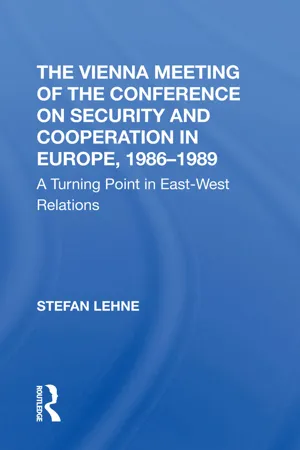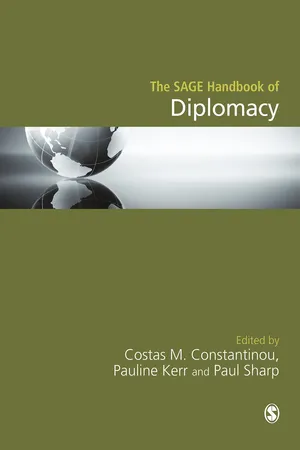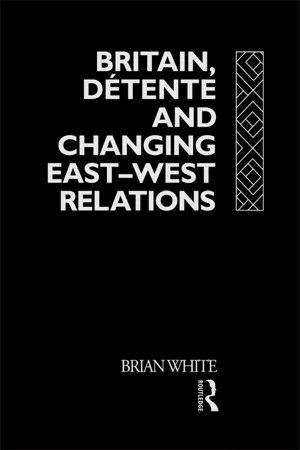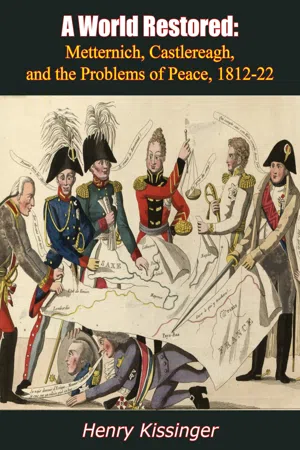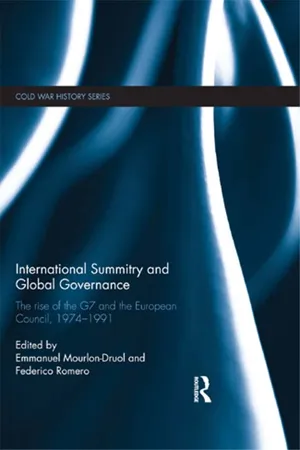History
The Vienna summit
The Vienna Summit, held in 1961, was a meeting between the leaders of the United States and the Soviet Union, John F. Kennedy and Nikita Khrushchev, respectively. The summit aimed to ease Cold War tensions, but ultimately failed to produce any significant agreements. The discussions highlighted the ideological divide between the two superpowers and set the stage for future confrontations.
Written by Perlego with AI-assistance
Related key terms
6 Key excerpts on "The Vienna summit"
- eBook - ePub
The Vienna Meeting Of The Conference On Security And Cooperation In Europe, 19861989
A Turning Point In East-west Relations
- Stefan Lehne(Author)
- 2019(Publication Date)
- Routledge(Publisher)
perestroika and the emergence of strong nationalist movements in most non-Russian parts of the Soviet Union also increased awareness of the enormity of the Soviet predicament. The perception of the Soviet Union as an expansionist superpower gradually gave way to an image of a sick giant with uncertain prospects of recovery. Nothing illustrates this change of attitude better than the fact that during 1988 and 1989 much of Western debate on East-West issues focused on the question of "helping Gorbachev." Although this discussion remained inconclusive, most Western governments, to their credit, appeared ready to use the historic opportunity for a significant improvement of East-West relations. Arms control and disarmament, particularly in the areas of conventional forces, strategic nuclear weapons, and chemical weapons received new attention. Diplomatic efforts to defuse Third World crises achieved first results, and cooperation in a broad range of areas intensified considerably.What was the role of the Vienna meeting during such a time? One important function was to serve as a forum for an ongoing dialogue on the developments in the East. For the reform-oriented East European governments, the Vienna meeting offered an opportunity to explain their new approach to internal and foreign policy. They could thus highlight the contrast to their own past policies and to those of their more conservative neighbors. Poland and, in particular, Hungary used their increased freedom of action to the hilt and sharply diverged from the positions taken by other Warsaw Pact members. The independent profile achieved by these countries was important, both in helping to further expand their room for maneuver as well as an example to other Eastern states. The Soviet Union's attitude to the Vienna meeting appeared for a long time ambiguous. Proposals like the Moscow conference initiative were clear demonstrations of "new thinking." But the Soviet Union's confrontational line in the implementation debate and the slow evolution of its substantive positions initially raised doubts about the extent to which the CSCE process would be used as a vehicle for Gorbachev's new foreign policy. Only in mid 1988 did it become clear that the Soviet leadership had opted for a very positive approach that would turn the conference into a milestone on the journey to better East-West relations.The role of the Vienna meeting as a monitoring instrument for developments in the East was particularly important in the human dimension. Human rights activists in the East, nongovernmental organizations (NGOs) in the West, and the Western and neutral delegations at the meeting combined to form an effective trilateral mechanism to promote respect for human rights. Through their relentless and detailed criticism of human rights violations, based for the most part on information supplied by Eastern activists and Western NGOs, Western delegations helped to identify the most severe shortcomings, established criteria for the improvement of the human rights record, and contributed to mobilize the political will necessary to carry out the required changes. - eBook - ePub
- Costas M. Constantinou, Pauline Kerr, Paul Sharp, Costas M. Constantinou, Pauline Kerr, Paul Sharp(Authors)
- 2016(Publication Date)
- SAGE Publications Ltd(Publisher)
With the dawn of the nuclear age, a new motive arrived for summit diplomacy, especially as the issue was considered too important to be left to the diplomats. The frequency of summits was initially due, as Churchill envisaged, to the nature of political crises that required a speedy conclusion to grave international questions. Politicians thus became far more involved in the detailed process of international dialogue. As the number of nuclear states proliferated, so did the need for summits to either ease tensions with long term negotiations – SALT I took three years to be agreed – or to address immediate crises, such as between India and Pakistan when tensions reached an apogee as both held nuclear tests in May 1998. The Lahore Summit in 1999, with its resultant declaration, was seen as a watershed agreement, but the following Agra Summit in 2001 failed to reach agreement. However, the atmospherics of the negotiation and engagement were themselves progress in a bitter, nuclear relationship (Baral 2002). Other summits between nuclear powers had more tangible and immediate results, particularly Kosygin and Zhou Enlai's summit in Beijing in 1969, which halted the fighting on their border that had already killed 3,000 troops. They then resumed border negotiations, begun earlier in 1964, and continued them at deputy foreign minister level without much progress till the summit of Gorbachev and Deng Xiaoping in 1989 (Wang 2003: 399–401). New global concerns, such as the environment and terrorism, are often addressed either by international summits – such as Rio de Janeiro in 1992 and Copenhagen in 2009 – or by hosted summits such as President Obama's 2015 ‘Summit on Countering Violent Extremism’ in the White House.The increased need for summits has been matched by the declining logistical difficulties of bringing leaders together rapidly. Technology allows summits to be arranged far more swiftly and with the minimum of disruption to other business. Where embassies with ambassadors holding plenipotentiary powers had been established out of necessity rather than choice, the development of air travel collapsed the time required to travel and meet. The development of ‘crisis management’ as a discrete activity, separate from regular diplomatic dialogue, is also accentuated by this trend. At the emissary level, the ‘shuttle diplomacy’ of Dulles, Kissinger and Haig are further examples of this trend, as are the contemporary travels of Hilary Clinton and John Kerry.The developments in communication technology have altered the nature of diplomacy. Over the last two centuries, innovations such as the wireless have allowed faster communication between the embassy and the capital (Nickles 2003) – Kennan's ‘Long Telegram’ probably the most famous, and the Zimmerman Telegram one of the most dangerous – but it also meant greater centralisation of diplomacy evolving into leaders communicating directly, increasing the contact between leaders and their involvement in foreign policy matters. Being more familiar with the issues and their opposite numbers has also encouraged this growth. Political leaders now regularly bypass formal diplomatic channels. President Carter, for example, happily reached for the telephone to the Prime Minister of the UK or the Chancellor of West Germany, often not even bothering to tell the resident ambassador (Jenkins and Sloman 1985: 129). President George H.W. Bush largely built the international coalition that fought the 1991 Gulf War by extensive personal diplomacy, conducted largely over the telephone, with numerous heads of government (Freedman and Karsh 1994: 107). The same type of technology allows constant communication between a leader and his delegation and the wider field of advisors back home, something particularly useful for protracted talks. - Brian White(Author)
- 2002(Publication Date)
- Routledge(Publisher)
The most significant outcome of Geneva was the general perception that a world war involving nuclear weapons had become less likely. ‘There ain’t gonna be no war’, said Macmillan laconically as he left Geneva (Bell, 1962, p. 130). ‘Geneva has given this simple message to the world: it has reduced the dangers of war’, concluded Eden’s report to the House of Commons (Eden, 1960, p. 311). These perceptions were reinforced by the fact that the summit produced the tentative beginnings of an East-West accommodation. Both sides tacitly recognized the territorial status quo in Europe, and to that extent, Soviet control of Eastern Europe had ceased to be a casus belli. Thus, the ‘summitry’ of 1955 was a landmark in the détente process, although, paradoxically, it also served to highlight the limitations as well as the potential of détente. The ‘Spirit of Geneva’ continued to affect the general climate of international relations in 1956, but the process of accommodation had gone as far as it could at that stage. This account suggests that Britain deserves most of the credit on the Western side for the diplomatic activity culminating in the Geneva conferences. There was a striking continuity through the governments of Churchill and Eden in the British voice calling for a normalization of relations with the Soviet bloc, and for much of this period that voice belonged literally to Winston Churchill- eBook - ePub
The Moscow Summit, 1988
Reagan And Gorbachev In Negotiation
- Joseph G. Whelan(Author)
- 2019(Publication Date)
- Routledge(Publisher)
116c. The General Secretary’s Toast
In a responding toast, the General Secretary reviewed the course of Soviet-American relations, candidly acknowledging the good times and the bad. The Geneva Summit marked the beginning of an era when both countries sought to “overcome a long drawn out period of confrontation” and reach an “acceptable level from which is now easier to move forward.” In their meetings at the summit, including Moscow, Gorbachev stated frankly, “our dialogue has been intense.” But he pointed to the “most important result,” the signing of the INF Treaty, among others: progress in reducing strategic offensive weapons; the accord on Soviet withdrawal from Afghanistan; and the fact that 47 bilateral agreements on cooperation were in force.The main tendency in world developments, Gorbachev went on, is the “turning toward a search for political solutions, toward cooperation and peace.” Momentous changes have occurred, but “a lot still has to be done to achieve irreversible change.” Despite cooperation and growing trust, “prejudices and stereotypes are still with us, as is rivalry, above all in the military sphere.” Nonetheless, at this summit, “we can register some headway toward better mutual understanding in this area as well.”The General Secretary then proceeded to share his views with the President on problems in the Third World and to reflect on the state of Soviet-American bilateral relations. Gorbachev called for a solution of Third World problems (which he cited as, “glaring backwardness,” hunger, poverty, mass diseases and an “incredibly high debt”) by a “radical restructuring of the entire system of world economic relations, without any discrimination for political reasons.” Such a course would “promote a political settlement of regional conflicts” that impede progress in the Third World and cause “turmoil in the entire world situation.” - eBook - ePub
A World Restored
Metternich, Castlereagh, and the Problems of Peace, 1812-22
- Henry Kissinger(Author)
- 2017(Publication Date)
- Friedland Books(Publisher)
IX—THE CONGRESS OF VIENNA
I
ARTICLE XXXII of the Peace of Paris had provided for a congress to be held in Vienna which was to settle the problem of the European equilibrium and to which all the powers engaged on either side during the war were invited. When this article was drafted, the Congress was expected to have a primarily symbolic significance, as the beginning of an era based on the reciprocal respect of sovereign states. The elements of the new equilibrium were to have been settled in London, where the Tsar, the King of Prussia, and Metternich repaired after the conclusion of the Treaty of Paris. It was almost an accident, therefore, that the Congress became the scene of a contest none the less bitter for the festivities surrounding it and all the more acrimonious because of the realization that the ultimate issues could no longer be evaded. For here at Vienna the final decision had to be taken whether out of the wars with Napoleon there could emerge a “legitimate” order, an order, that is, accepted by all the major powers, or whether relations would have to remain revolutionary, based on the unsupported claims of power.Any international settlement represents a stage in a process by which a nation reconciles its vision of itself with the vision of it by other powers. To itself, a nation appears as an expression of justice, and the more spontaneous its pattern of social obligations, the more this is true; for government functions effectively only when most citizens obey voluntarily and they will obey only to the extent that they consider the demands of their rulers just. To others, it appears as a force or an expression of will. This is inevitable because external sovereignty can be controlled only by superior force and because foreign policy must be planned on the basis of the other side’s capabilities and not merely of its intentions. Could a power achieve all its wishes, it would strive for absolute security, a world-order free from the consciousness of foreign danger and where all problems have the manageability of domestic issues. But since absolute security for one power means absolute insecurity for all others, it is never obtainable as a part of a “legitimate” settlement, and can be achieved only through conquest. - eBook - ePub
International Summitry and Global Governance
The rise of the G7 and the European Council, 1974-1991
- Emmanuel Mourlon-Druol, Federico Romero(Authors)
- 2014(Publication Date)
- Routledge(Publisher)
It is the argument of this chapter that summits proved both useful and effective in deepening trust and broadening Western coordination on matters where consensus already existed among members as to how to approach East–West relations. Indeed, in the mid-1970s, economic summits of Western countries did contribute, inter alia, to the coordination of Western policies towards the Soviet Union and Eastern Europe on trade and financial matters. Discussions held with a view to avoiding unfair economic and financial competition between Western countries reached concrete results; namely the OECD guidelines on export credits. Conversely, when the US and Western European allies drifted apart on fundamental features of policy towards the USSR and East–West relations, the G7 mechanism proved unable to produce substantial results or to be helpful in actually reconciling conflicting positions. A review of the Ottawa and Versailles meetings’ declarations shows that they were timid attempts at hiding dissonance, while calls for further consultations on export controls, credits and all aspects of economic, commercial and financial relations with the Soviet Union and Eastern Europe simply revealed the lack of agreement. Moreover, G7 summits did not pre-empt unilateral action detrimental to partners. In fact, in the immediate aftermath of the Versailles summit, Reagan extended the gas pipeline-related embargo to Western European companies using US licences and equipment, causing a major transatlantic clash.Concluding, the degree of summit effectiveness in coordinating Western policies towards the East, and particularly the Soviet Union, varied widely according to the existing state of East–West relations (détente or crisis) and leaders’ ideas and visions at the time (détente vs. confrontation, economic cooperation and exchange vs. economic warfare). Coordination proved easier at times of good East–West relations, expanding trade and cooperation across the Iron Curtain. Western coordination in the 1970s was possible, and successful, because all participants shared the belief that détente should be preserved and enhanced for political and economic reasons, and that improving such relations served this cause well. Summitry served the function of deepening existing trust and consensus, affording the industrialised Western countries space to devote their efforts to ‘simply’ establishing fair rules of competition between them. When major crises erupted between 1979 and 1981, the debate forcefully shifted to the fundamental core political visions of East–West relations. US policy, which had always been discontinuous and inclined to a moralistic stance, turned to using economic leverage first as a stick to punish Soviet bad behaviour and then as a weapon to win the Cold War. For their part, the European governments, though not acquiescing to the Soviets, stood firm in pursuit of their policy of détente and continued in what had been a long-established and long-term policy of change through rapprochement. In the presence of such deep divisions on approach, not even summits were able to reconcile positions or clear up misunderstandings; if anything, the necessity to at least appear able to reach agreement sometimes actually created them.
Index pages curate the most relevant extracts from our library of academic textbooks. They’ve been created using an in-house natural language model (NLM), each adding context and meaning to key research topics.
